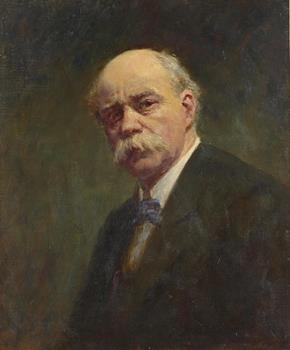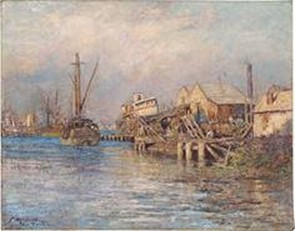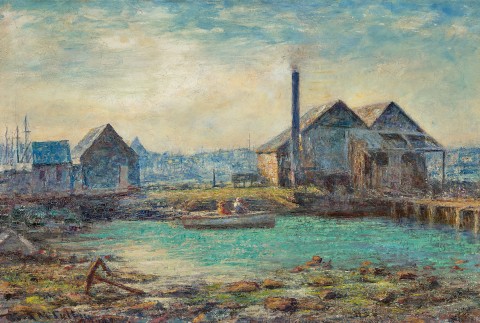WILLIAMSTOWN LANDSCAPE, 1909
FREDERICK McCUBBIN
oil on canvas
61.0 x 91.5 cm
signed and dated lower left: F McCubbin / 1909
The artist, until 1917
Thence by descent
Louis McCubbin, Melbourne
National Gallery of South Australia, Adelaide, acquired from the above in 1952
Company collection, Sydney, acquired from the above in 1993
The National Australia Bank Art Collection, acquired from the above in 1995 (label attached verso)
Frederick McCubbin Exhibition to Mark the Centenary of the Artist's Birth in 1855, National Gallery of Victoria, Melbourne, 4 November – 31 December 1955, cat. 29, and touring to Art Gallery of South Australia, Adelaide, January – February 1956, and the Art Gallery of New South Wales, Sydney, March 1956
Making Melbourne: Marvellous Melbourne - Industrial City, Gold Treasury Museum, Melbourne, 5 June – 5 December 2003 (as 'Williamstown')
Francis, I., 'On Exhibition at Gallery', The News, Adelaide, 22 October 1952, p. 2 (illus.)
'Recent Purchases', The Advertiser, Adelaide, 22 October 1952, p. 2
George, E., 'SA Purchases', The Mail, Adelaide, 1 November 1952, p. 42
‘“Williamstown Landscape”, by Frederick McCubbin (1855–1917)’, Quarterly Bulletin, National Gallery of South Australia, Adelaide, vol. 14, no. 2, October 1952, p. 4 (illus.)
Hoff, U., Frederick McCubbin Exhibition to Mark the Centenary of the Artist’s Birth in 1855, National Gallery of Victoria, Melbourne, 1955, cat. 29 (illus.)
Hoff, U., ‘The Phases of McCubbin’s Art’, Meanjin, Melbourne, vol. 15, no. 3, September 1956, p. 305
Galbally, A., Frederick McCubbin, Hutchinson, Melbourne, 1981, pl. 36, pp. 135, 136 (illus.), 150, 151
Mackenzie, A., Frederick McCubbin 1855 – 1917: 'The Proff' and his art, Mannagum Press, Melbourne, 1990, p. 204
Whitelaw, B., The Art of Frederick McCubbin, National Gallery of Victoria, Melbourne, 1991, p. 120
Ingram, T., ‘Moving The Masterpieces’, Australian Financial Review, Sydney, 10 March 1994
Dodgshun, B., 'On loan: Williamstown, 1909 by Frederick McCubbin', Treasured Moments: Newsletter for Staff at the Gold Treasury Museum, Melbourne, 2005
Study for Williamstown Landscape, c.1909, oil on canvas board, 24.0 x 34.0 cm, private collection
Williamstown, 1909, oil on canvas, 33.0 x 48.0 cm, private collection
Wharves at Williamstown, c.1909, whereabouts unknown, illus., in Melba’s Gift Book of Australian Art and Literature, George Robertson & Co. Pty. Ltd., Melbourne, c.1915, p. 144
210720 Frederick McCubbin Self portrait, c.1913.jpg

The sparkling waters of Melbourne’s bayside suburb Williamstown were for Frederick McCubbin like those of Sydney and its harbour for Arthur Streeton. His enthusiasm can still be felt today in the lively seascapes and letter of the summer of 1909 to his old friend Tom Roberts:
I have been down at Williamstown for a few poschards [rough sketches], my dear boy just like Venice, lovely colour. Water and sky and an old ship… the older I get the wider my interest grows in all life, colour, charm.1
Born in King Street, not far from the Melbourne docks, McCubbin’s interest in ships and docklands began early. It continued when, as a teenager, he drove one of his father’s bread carts ‘through North Melbourne down to the boats at the wharves’.2 View of the New Dock, 1880 (private collection) is one of his earliest oil paintings. Others followed – The City’s Toil, 1887 of Smith’s Wharf Yarra Yarra (Wesfarmers Collection) and Melbourne 1888, 1888 (National Gallery of Victoria, Melbourne). The Williamstown series, however, had its more immediate genesis in the oil sketches painted during McCubbin’s 1907 trip to England – of sunlit waters in The Blue Mediterranean, c.1907 (formerly in the collection of the late Professor Bernard Smith, Melbourne); Mount Vesuvius, Naples, c.1907 (Deutscher and Hackett, Melbourne, 26 August 2009, lot 50); and busy shipping scenes on the River Thames, as in The Pool of London, 1907 (National Gallery of Victoria).
Of the many colourful works McCubbin painted at Williamstown in that summer of 1909, Williamstown Landscape, 1909 is one of the finest. A favourite spot, he painted four versions – Sketch for ‘Williamstown Landscape’; Williamstown; Wharves at Williamstown; and Williamstown Landscape, detailed above. Working out of doors, McCubbin made small, atmospheric sketches in oil (usually 25 x 35 centimetres), translating select ones onto larger canvases in the studio, as in our painting. Introduced by Study for ‘Williamstown Landscape’, c.1909, its bright colours are deftly handled with broad brush and palette knife. Prestigious previous ownership includes the artist, Esther Paterson, and Melbourne art dealer Georges Mora. Next, Williamstown, 1909, also of distinguished provenance, having been purchased from the artist by Lawrence Abrahams, is larger in size and painted on canvas. It and Wharves at Williamstown (illustrated in Melba’s Gift Book) are closest to the painting on offer.
Although again larger, Williamstown Landscape, 1909 remains medium of size, retaining the empathy of the smaller work. The humanising feeling continues through the centrally placed two figures in the boat. (The figures were probably introduced from another sketch, Figure Group, Williamstown, c. 1909, the background buildings in the sketch being similar to those of Williamstown Landscape, 1909.3) Key placement of figures, particularly children, in the landscape is characteristic McCubbin, seen in such masterly paintings as Lost, 1886 (National Gallery of Victoria) and throughout his oeuvre. In Williamstown Landscape, 1909 the narratives of the early years give way to the bravura handling of colour and light of his later style – the red shirt of one, and the sunlight striking the white hat and shirt of the other. And all is enveloped in a luminous atmosphere, almost aqueous. Blue skies and waters predominate throughout these paintings. One is even acknowledged with the title Harmony in Blue, Williamstown, 1909 (formerly George Page Cooper collection, Melbourne).
01.jpg

Significantly, when the National Gallery of Victoria held its McCubbin centenary exhibition in 1955, Williamstown Landscape, 1909 and Williamstown, 1909, the study from the Abrahams’ collection, were the only two selected to represent the series. Our painting also had the distinction of being one of the few illustrated in the catalogue.4 Curated by Ursula Hoff, the following year Meanjin published her perceptive article on McCubbin, referring to his use of the open-air sketch preparatory to the larger canvases ‘painted in the studio, in a manner combining the broken colour of Impressionism with poetic romanticism.’ She continued:
One such sketch was Williamstown 1909 (Harry Abrahams Esq.). It was to be seen in the Centenary Exhibition alongside the larger work from the Adelaide National Gallery. The open-air sketch, with its very bright blues and greens intermingling with spots of red shows an even more romantic heightening of colour than the finished picture, in which both colour and composition have been slightly conventionalized. … McCubbin saw Williamstown through the eyes of Turner.5
McCubbin’s life-long interest in J.M.W. Turner – especially his late works and watercolours of Venice – increased considerably after being admired at first hand during his visit to England in 1907. Describing them as ‘dreams of colour’, Williamstown gave McCubbin the opportunity to paint his own spontaneous works of sparkling light.6 Some twenty-five Williamstown subjects are known, twenty-three in oil, two in watercolour. Most were painted on sketching tablets. The watercolours, Williamstown, c. 1909 (Art Gallery of South Australia) and Mid-Summer Glow, c.1909, (formerly McCubbin Family) are highly Turneresque.7 Complete within themselves, they also served as studies for the major oil painting of the series, The Old Ship, Williamstown, c.1909 – 15 (private collection). Its view is taken from the other side of the sheds in our painting.
PLACEHOLDER FOR 210720 THE OLD SLIP.jpg

The serenity of early summer and the glow of afternoon light are beautifully expressed in this canvas by means of broken touches of opalescent colour, laid on with a palette-knife. The mood is that of romantic impressionism.10
Williamstown Landscape, 1909 with its romance of light and colour represents a singular work in McCubbin’s oeuvre.
1. Frederick McCubbin letter to Tom Roberts, 27 January 1909 (Letters to Tom Roberts, vol. II, no. 18, Mitchell Library, State Library of New South Wales)
2. MacDonald, J., The Art of Frederick McCubbin, Lothian Press, Melbourne, 1916, p. 40
3. Spring Exhibition, Joseph Brown Gallery, Melbourne, 1 – 10 September 1980, cat. 62 (illus.), as ‘Williamstown’
4. Frederick McCubbin Exhibition, To Mark The Centenary of the Artist’s Birth in 1855, National Gallery of Victoria, Melbourne, 1955, cats. 28 and 29
5. Hoff, U., ‘The Phases of McCubbin’s Art’, Meanjin, Melbourne, vol. 15, no. 3, 1956, p. 305
6. Frederick McCubbin letter to Annie McCubbin, 19 July 1907, McCubbin Papers, La Trobe Library, State Library of Victoria, MS8525La
7. Mid-Summer Glow, c.1909, watercolour, 23 x 24 cm, sold Christie’s, Melbourne, 3 May 1988, lot 140
8. Francis, I., ‘Aust. pictures help gallery’, The News, Adelaide, 22 October 1952, p. 2
9. George, E., ‘Art’, The Mail, Adelaide, 1 November 1952, p. 42
10. ‘ “Williamstown Landscape” by Frederick McCubbin (1855-1917)’, Bulletin of the National Gallery of South Australia, vol. 14, no. 2, October 1952, np. (illus.)
DAVID THOMAS
